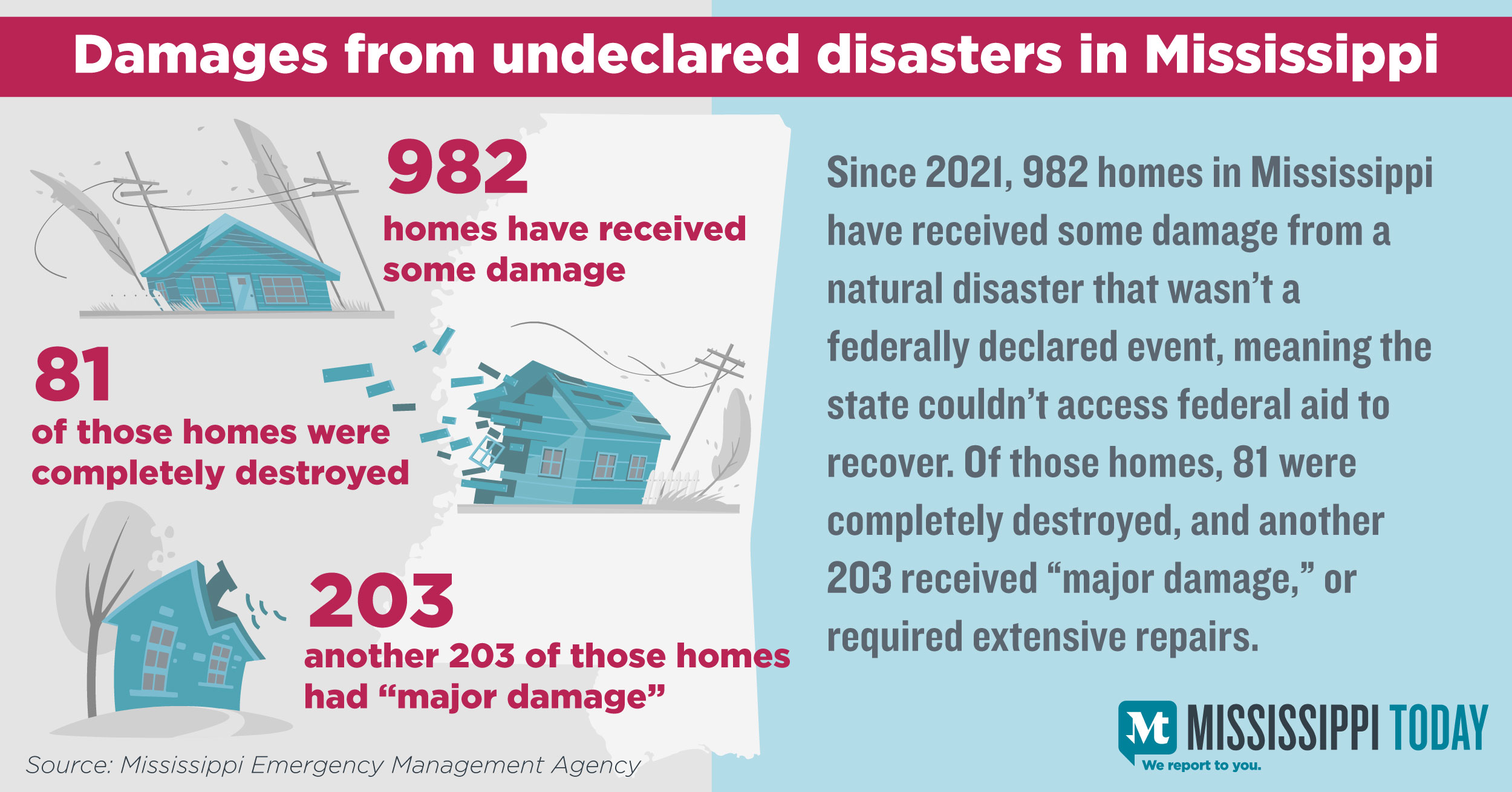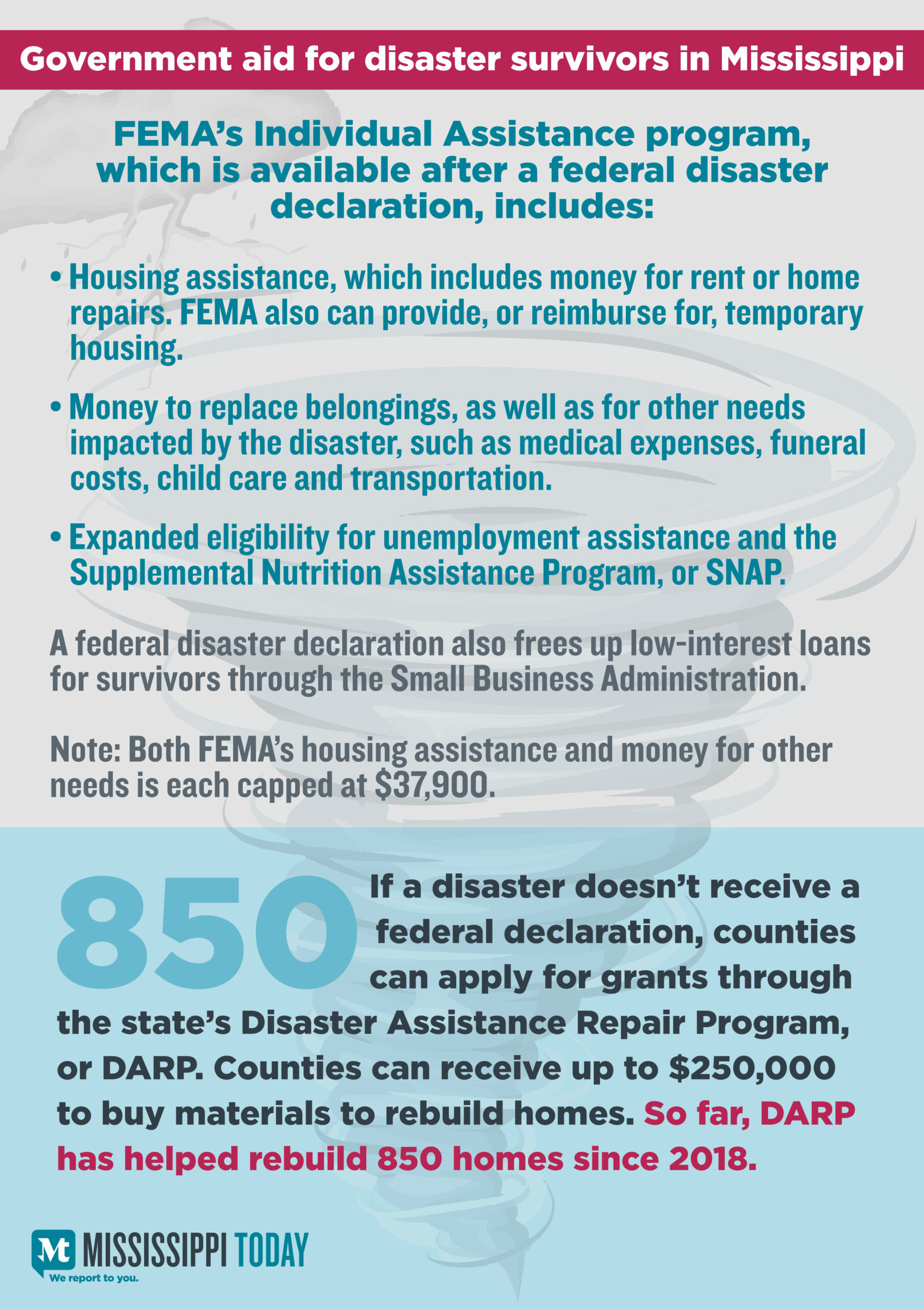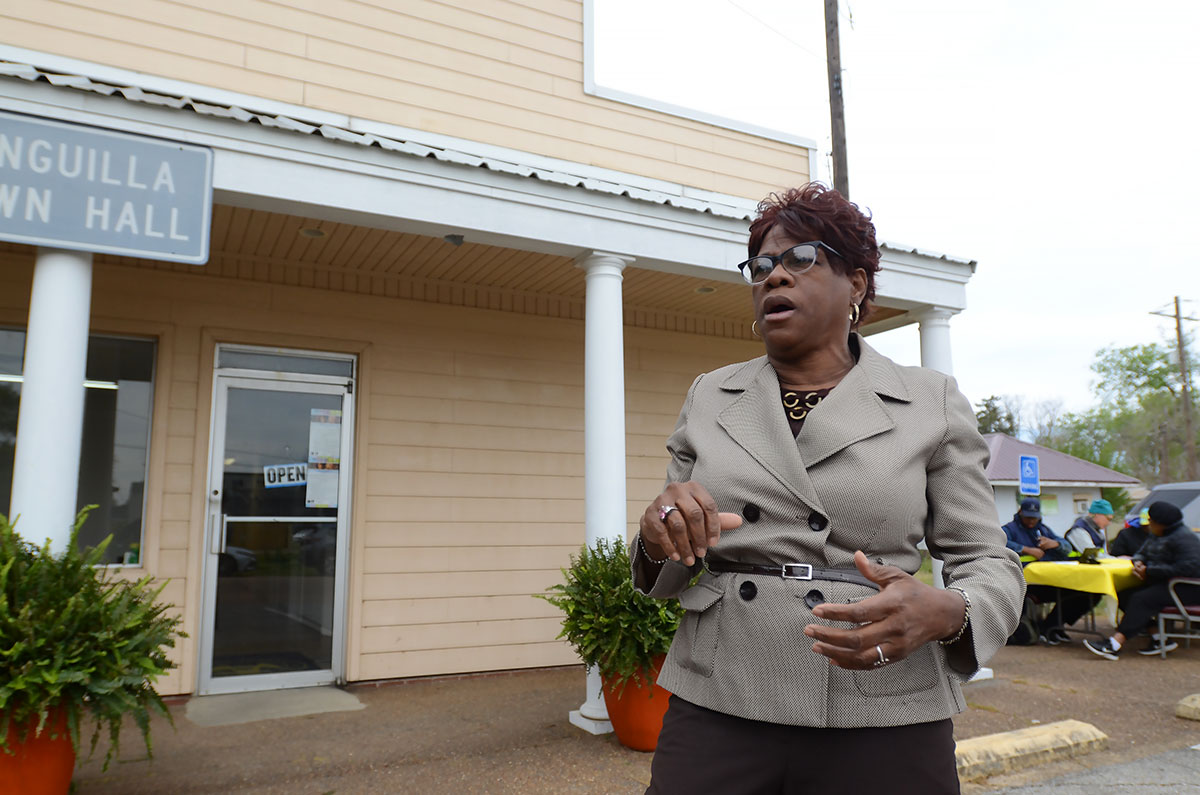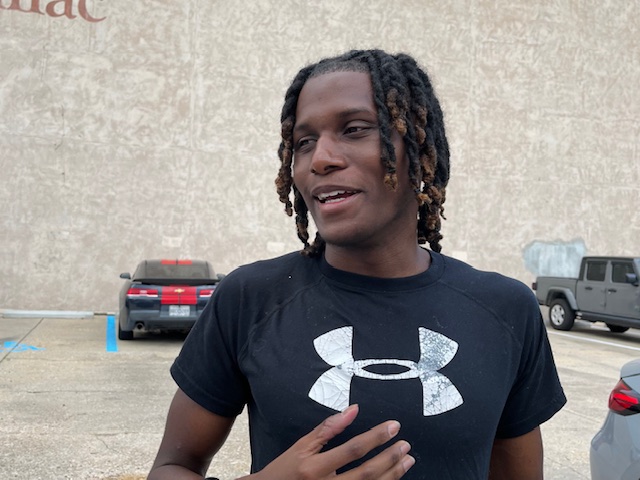Mississippi Today
When disasters are deemed too small, rural Mississippi struggles to recover
Under a mystic blend of pink lightning and green sky, Victoria Jackson called her daughter in a panic, warning her of the news: A tornado was on a path towards Rolling Fork.
Her daughter was working that March night at Chuck’s Dairy Bar, a staple of the small, south Delta town. Along with some customers, Jackson’s daughter, Natasha, nestled into one of the coolers in the restaurant.
Hours later, once the storm blew by, Jackson headed to find her daughter, navigating through debris. She found Natasha shaking, in tears. While the tornado tore the rest of Chuck’s into shreds, the cooler and those inside it were safe.
“I thank God that I called her and told her to get down,” Jackson told Mississippi Today.
The tornado killed 14 people in Sharkey County, and left Rolling Fork with little resemblance of its prior self. While the Jacksons didn’t lose anyone or anything that night, the reason they were in Rolling Fork in the first place is because, three months prior, they lost everything.

The first tornado the Jacksons survived wiped away their homes last December, tearing up a trailer park where they lived in Anguilla. Victoria, her sister, aunt, cousin and everyone in their families lost their homes, among five total that were destroyed. About 20 members of the family had to relocate a few miles down Highway 61 to a motel in Rolling Fork. Many of them, including Victoria, are still there.
As is often the case for rural disaster survivors, the damages they endured were too small to trigger crucial federal aid. Victoria didn’t have home insurance and lost her job after the storm. Now, nearly six months later, her family hasn’t seen a cent of government disaster aid, and are instead counting on donations to put them in a real home again.
Disaster recovery is already an often difficult and drawn-out process. But for rural, poor towns like Anguilla, a town of 496 people, it’s even tougher.
When people think about disaster recovery, they often think of “FEMA” – the Federal Emergency Management Agency, the national hub of government disaster aid. In reality, though, a vast majority of the country’s disasters don’t receive any FEMA money. They’re what experts call “undeclared” events.
“If you were to aggregate all the losses tied to undeclared disasters, they actually are more costly than typically declared disasters,” said Gavin Smith, a professor of Landscape Architecture and Environmental Planning at North Carolina State University who has helped lead recovery efforts in multiple states.

In Mississippi, nearly a thousand homes have been damaged in undeclared disasters in just the last two years, state records show.
FEMA aid, which comes when the president signs a disaster declaration, is reserved for the larger disasters that leave states needing additional resources. But when a disaster doesn’t meet that threshold, most states, including Mississippi, can’t replicate the kinds of services FEMA can offer.
The programs states receive after a federal declaration include: paying for public infrastructure repairs, putting people in temporary housing, sending direct payments to survivors, expanding safety net programs like food stamps and uninsurance benefits, among others.
Since more often than not, FEMA money is unavailable, many disaster survivors rely on their home insurance to pay for repairs.
But low-income, uninsured families like the Jacksons have to instead depend on the slow, complex network of volunteers and charities. Nonprofits and national religious groups help struggling communities recover all over the country, collecting donations to help rebuild homes, and providing otherwise costly labor for free. But that process takes time.
“If they’re back and recovered within six months, that is like warp speed for these organizations,” said Michelle Annette Meyer, the director of the Hazard Reduction & Recovery Center at Texas A&M University. “At best, they’re looking at a year-long process to get the donations in, confirm the paperwork, get the volunteers and get the materials donated.”
For Sharkey County, where Anguilla and Rolling Fork are, the nonprofit Delta Force handles disaster recovery, finding new homes for survivors after undeclared events. Delta Force’s chairman, Martha Bray, wouldn’t comment on specific cases for privacy reasons, only saying that they’re waiting for enough donations to come in to buy new mobile homes for the Jacksons.
“It’s going to be a long process, that’s all we hear,” Victoria Jackson said.

Last December, just before Christmas and after the tornado destroyed her home, Jackson lost her retail job at a local shop. She said her boss didn’t let her come back despite giving her time off after the storm, and then listed her as having quit, which blocked her from unemployment benefits.
Now, she’s sharing a two-bed room with her husband and six kids at the Rolling Fork Motel.
Jackson said she received $2,500 in initial donations from local churches and charities. But expenses like food, gas, laundry, and taking care of her children quickly dried that money up. Since her daughter Natasha lost her job at Chuck’s Dairy Bar, the family’s relying on her husband’s truck-driving job to keep them afloat.
After the December tornado, Anguilla Mayor Jan Pearson reached out to state and U.S. representatives, hoping that they could appeal for government assistance. The traces of the tornado were widespread in the small town, damaging businesses and even blowing the roof off the town’s middle school, forcing students to relocate.
“I wrote all of them a letter,” Pearson said. “However, to no avail. We did not get anything.”
County officials, Pearson said, told her the damages didn’t meet the threshold for federal assistance.
“I keep hearing we didn’t meet the threshold,” she said. “Well I asked somebody, ‘Will you tell me what the threshold is?’ No one could tell me what the threshold is.”

For Individual Assistance, the FEMA program that includes housing and other direct support for survivors, there is no set threshold, officials told Mississippi Today.
“It is kind of subjective,” FEMA spokesperson Mike Wade said.
FEMA weighs several factors, such as the degree of damages and the amount of uninsured losses, when deciding if a declaration is justified. The agency categorizes damages into several categories, ranging from “affected” to “destroyed.”
But to local and state officials, FEMA’s criteria is unclear.
In the summer of 2021, for instance, heavy rain flooded 284 homes in the Delta. While local officials pleaded for federal support, the state informed them that not enough of the homes received “major damage,” which FEMA defines as needing “extensive repairs.”
Last March, 33 tornadoes touched down in Mississippi, destroying 42 homes across a dozen counties. The state applied for a federal declaration, but was denied.
While there’s no set threshold, the Mississippi Emergency Management Agency estimated that at least 50 homes need major damage to earn a federal declaration.
But the damages from undeclared disasters in just the last couple years dwarf that number.
Since 2021, 982 homes in the state received some damage from an undeclared natural disaster, according to records from MEMA; 81 of those homes were completely destroyed, and another 203 received major damage.
“When you look at only one of (the undeclared disasters), the damage may be relatively small,” said Andrew Rumbach, a senior fellow at the Urban Institute whose research focuses on rural recovery efforts. “But when you add all those up across the state, it actually cumulatively could be much more important than some of those big events that do get that support.”
Anguilla has just 250 households, according to the Census. Sharkey County Supervisor Jesse Mason, who represents Anguilla, wondered how such a small place could reach the amount of damages that FEMA looks for.
“I don’t know what the magic number is,” Mason said. “I guess maybe it had to tear the whole town up.”

Rural areas have an especially hard time getting FEMA disaster aid, experts say. Mississippi was the fourth most rural state according to a 2010 Census survey, the latest with such data. Sharkey County, home to 3,488 people, is the second least populated county in the state. Neighboring Issaquena County is the first.
“The more rural you are and the more scattered your population and assets are, sometimes those kind of events are the ones that slip under the radar compared to the events where there’s media, for example, to immediately cover it, or there’s political pressure to immediately make declarations,” Rumbach said.
Mississippi has a program that sends money to counties after undeclared disasters. The Disaster Assistance Repair Program, or DARP, works with local nonprofits, and sends up to $250,000 for materials to rebuild homes. Meyer, the Texas A&M professor, said that’s more than what most states do after undeclared events.
Since 2018, DARP has helped rebuild 850 homes in 22 counties. But Sharkey County hasn’t applied for DARP funds to help the Anguilla survivors, and officials couldn't be reached to explain why.
Every county in the state has emergency management officials. But in Sharkey County, there are only two such employees, and both work part-time. Counties with lower tax bases and less capacity to do damage assessments struggle to make the case for disaster declarations, Rumbach said.
One of those two employees, Natalie Perkins, also runs the local weekly newspaper. After the Rolling Fork disaster, which President Joe Biden approved for federal aid, Perkins saw firsthand the difference a declaration makes.
“When you have a declared disaster, everyone comes out of the woodwork to help,” she said. “But when you have an undeclared (event), you don’t get the attention, you don’t get the donations, you don’t get the federal and state funding that you do in a declared disaster. That’s just the bottom line.”

On the morning of Mar. 29, five days after the tornado in Rolling Fork, which also damaged parts of Anguilla, Mayor Pearson scrambled to help FEMA officials set up a booth outside of the town hall.
Pearson sat down with Mississippi Today to talk about the December tornado, the one that displaced the Jacksons. She emphasized that she didn’t want to take away attention from what happened in Rolling Fork. But she couldn’t hold back frustration over the lack of help Victoria Jackson and her family received.
“These people just three months ago lost their homes,” the mayor said. “I can’t equate Rolling Fork with Anguilla. But come on now, people are people, humans are humans. The (Jacksons) left Anguilla and came to Rolling Fork. Now a tornado hit Rolling Fork. These people don’t have anything, and you’re telling them they can’t qualify (for FEMA aid)?”

At the motel, the Jacksons accused the owner of poor treatment, saying he recently raised their weekly rent to $400, and charges extra to wash their sheets. When reached for comment, the motel staff said the owner was out of the country and couldn’t comment. Meanwhile, the Jacksons don’t know how much longer they’ll be able to afford the room.
That Wednesday, while federal officials were in Anguilla, Victoria tried to apply for FEMA aid. They called back later, she said, telling her she’d been denied. While the agency won’t comment on specific cases, FEMA confirmed that aid wasn’t available for people in her situation.
“We just need the help that they’re giving other people,” Jackson said, wondering why she and her family had been left out. “Anguilla is Sharkey County, Rolling Fork is Sharkey County, so all this should be combined together, right? Help for everybody, right?”
This article first appeared on Mississippi Today and is republished here under a Creative Commons license.
Mississippi Today
Indicted Jackson prosecutor’s latest campaign finance report rife with errors
Tangled finances, thousands in personal loans and a political contribution from a supposed investor group made up of undercover FBI informants — this was all contained in a months-late campaign finance report from Hinds County District Attorney Jody Owens.
Owens, a second-term Democrat in Mississippi’s capital city region, is fighting federal bribery charges, to which he’s pleaded not guilty. At the same time, his recent campaign finance disclosure reflects a pair of transactions that correspond with key details in the government’s allegation that Owens took money from undercover informants to pay off a local official’s debt.
Regarding payments from Facility Solutions Team — the company name used in the FBI sting — to former Jackson City Councilwoman Angelique Lee, Owens allegedly stated the need to “clean it out,” according to the indictment, which was unsealed in November.
“[L]ike we always do, we’ll put it in a campaign account, or directly wire it,” he said, the indictment claims. “[T]hat’s the only way I want the paper trail to look.”
Agents recorded hundreds of hours of conversations with Owens and other officials, and after his arraignment last year, Owens responded to the charges, saying, “The cherry-picked statements of drunken locker room banter is not a crime.”
Throughout 2024, a non-election year during which federal authorities allege Owens funneled thousands of dollars in bribes to Jackson’s city officials, Owens loaned his campaign more than $20,000, according to his campaign committee’s finance report. He’d won reelection in late 2023.
Owens and his attorneys did not respond to questions about his campaign finance report.
Owens’ report, filed May 30 – months late and riddled with errors – is the latest example of how Mississippi politicians can ignore the state’s campaign finance transparency laws while avoiding meaningful consequences. It’s a lax legal environment that has led to late and illegible reports, untraceable out-of-state money that defied contribution limits, and, according to federal authorities, public corruption with campaign finance accounts serving as piggy banks.
Enforcement duties are divided among many government bodies, including the Mississippi Ethics Commission. The commission’s executive director, Tom Hood, has long complained that the state’s campaign finance laws are confusing and ineffective.
“It’s just a mess,” Hood said.
Owens filed the annual report months past the Jan. 31 deadline, after reporting from The Marshall Project – Jackson revealed he had failed to do so. He paid a $500 fine in April.
He was also late filing in previous years, paying fines in some years and failing to pay the penalties in other years, according to records provided by the Ethics Commission.
The report, which Owens signed, is full of omissions or miscalculations, with no way to tell which is which. The cover sheet of the report provides the total amount of itemized contributions and disbursements for the year — $44,000 in and $36,500 out. But the body of the report lists the line-by-line itemizations for each, and when the Marshall Project – Jackson and Mississippi Today summed the individual itemizations, the totals didn’t match those on the cover sheet.
Based on the itemized spending detailed in the body of the report, Owens’ campaign should have thousands more in cash on hand than reported. In the report’s cover sheet, Owens also reported that he received more in itemized contributions during the year than he received in total contributions, which would be impossible to do.
While the secretary of state receives and maintains campaign finance reports, it has no obligation to review the reports and no authority to investigate their accuracy. Under state law, willfully filing a false campaign finance report is a misdemeanor. Charges, however, are rare.
Owens is the only local official in the federal bribery probe — which is set to go to trial next summer — who remains in office. The government alleged that Owens accepted $125,000 to split between him and two associates in late 2023 from a group of men he believed were vying for a development project in downtown Jackson. Owens accepted several thousand dollars more to funnel to public officials for their support of the project, the indictment alleges. The use of campaign accounts was an important feature of the alleged scheme, according to the indictment.
Owens divvied up $50,000 from Facility Solutions Team, or FST, into checks from various individuals or companies — allegedly meant to conceal the bribe — to former Jackson Mayor Chokwe Lumumba’s reelection campaign, the indictment charged.
Lumumba accepted the checks during a sunset cruise on a yacht in South Florida, the indictment alleged. His campaign finance report, filed earlier this year, reflected five $10,000 contributions near the date of the trip, with no mention of FST.
Lumumba, who lost reelection in April, has pleaded not guilty.
While the indictment accused Owens of saying that public officials use campaign accounts to finance their personal lives, state law prohibits the use of political contributions for personal use.
The indictment alleges Owens accepted $60,000 — some for the purpose of funneling to local politicians — from the men representing themselves as FST in the backroom of Owens’ cigar bar on Feb. 13, 2024. On his campaign finance report, he listed a $12,500 campaign contribution from FST two days later, the same day the indictment alleges he paid off $10,000 of former Councilwoman Lee’s campaign debt. Lee pleaded guilty to charges related to the alleged bribery scheme in 2024.
Also on Feb. 15, 2024, the campaign finance report Owens filed shows a $10,000 payment to 1Vision, a printing company that used to go by the name A2Z Printing, for the purpose of “debt retirement.” Lee had her city paycheck garnished starting in 2023 to pay off debts to A2Z Printing, according to media reports. No mention of Lee was made in the campaign finance report filed by Owens. The printing company did not respond to requests for comment.
Campaigns are allowed to contribute money to other campaigns or political action committees. If Owens’ committee used campaign funds to pay off debt owed by Lee’s campaign, the transaction should have been structured as a contribution to Lee’s campaign and reported as such by both campaigns, said Sam Begley, a Jackson-based attorney and election law expert who has advised candidates about their financial disclosures.
The alleged debt payoff on behalf of Lee is not the first time Owens has described transactions on his campaign finance filings in ways that may obscure how his campaign is spending money. Confusing or unclear descriptions of spending activity are common on campaign finance reports across the state.
Owens previously reported that in 2023, he paid $1,275 to a staff member in the district attorney’s office who also worked on his campaign. The payment was labeled a reimbursement, which Owens explained in a May email to The Marshall Project – Jackson was for expenditures this person made on behalf of the campaign, “such as meals for volunteers/workers, evening/weekend canvassers, and election day workers.”
State law requires campaigns to itemize all contributions and expenses over $200. Begley said he believes Owens’ committee should have itemized any payments over $200 made by anyone on behalf of the campaign.
Upfront payments, with the expectation of repayment by the campaign, might also be considered a loan, according to a spokesperson for the secretary of state. Campaigns are barred from spending money to repay undocumented loans.
The state Ethics Commission has addressed undocumented loan repayments in several opinions, outlining the required documentation to make repayments legal.
Since 2018, the Ethics Commission has had the power to issue advisory opinions upon request to help candidates and campaigns sort through laws that Hood, the commission’s executive director, said aren’t always clear.
The commission has issued just six opinions in seven years.
“I was surprised in the first few years that there weren’t more,” Hood said. “But now it seems to be clear that for whatever reason, most people don’t think they need advice.”
This article first appeared on Mississippi Today and is republished here under a Creative Commons Attribution-NoDerivatives 4.0 International License.
The post Indicted Jackson prosecutor's latest campaign finance report rife with errors appeared first on mississippitoday.org
Note: The following A.I. based commentary is not part of the original article, reproduced above, but is offered in the hopes that it will promote greater media literacy and critical thinking, by making any potential bias more visible to the reader –Staff Editor.
Political Bias Rating: Center-Left
The article critically examines the conduct of Hinds County District Attorney Jody Owens, a Democrat, and highlights systemic weaknesses in Mississippi’s campaign finance laws. While the reporting is grounded in factual evidence, legal documents, and expert commentary, the tone leans toward exposing flaws in enforcement and transparency—issues typically emphasized by center-left or reform-oriented journalism. The article does not display partisan rhetoric or ideological framing beyond its focus on accountability and legal integrity. Its publication by Mississippi Today and The Marshall Project, both known for investigative work with slight progressive leanings, further supports a Center-Left classification.
Mississippi Today
Whooping cough cases increase in Mississippi
The Mississippi State Department of Health issued an alert Wednesday that cases of pertussis, or whooping cough, are climbing in the state.
The year-to-date number of cases in Mississippi ballooned to 80 as of July 10. That compares to 49 cases in all of 2024.
No whooping cough deaths have been reported. Ten people have been hospitalized related to whooping cough, seven of whom were children under 2 years old.
Cases have largely been clustered in northeast Mississippi. The region accounts for 40% of cases statewide.
The nation has also seen rising rates of whooping cough, though cases have been climbing less steeply than in Mississippi. About 15,000 whooping cough cases have been reported nationwide this year, according to the Centers for Disease Control and Prevention.
The highly contagious respiratory illness is named for the “whooping” sound people make when gasping for air after a coughing fit. It may begin like a common cold but can last for weeks or months. Babies younger than 1 year are at greatest risk for getting whooping cough, and can have severe complications that often require hospitalization.
Whooping cough cases fell in Mississippi after the COVID-19 pandemic began, but have since rebounded. This is likely due to people now taking fewer mitigation measures, like masking and remote learning, State Epidemiologist Renia Dotson said at the state Board of Health meeting July 9.
The majority of cases – 76% – have occurred in children. Of the 73 cases reported in people who were old enough to be vaccinated, 28 were unvaccinated. Of those 28 people, 23 were children.
“Vaccines are the best defense against vaccine preventable diseases,” State Health Officer Dr. Dan Edney said after the State Board of Health meeting.
Mississippi has long had the highest child vaccination rates in the country. But the state’s kindergarten vaccination rates have dropped since a federal judge ruled in 2023 that parents can opt out of vaccinating their children for school on account of religious beliefs.
The pertussis vaccination is administered in a five-dose series for children under 7 and booster doses for older children and adults. The health department recommends that pregnant women, grandparents and family or friends that may come in close contact with an infant should get booster shots to ensure they do not pass the illness to children, particularly those too young to be vaccinated.
Immunity from pertussis vaccination wanes over time, and there is not a routine recommendation for boosters.
State health officials also encourage vaccination against other childhood illnesses, like measles. While Mississippi has not reported any measles cases, Texas has had recent outbreaks.
The Mississippi Health Department offers vaccinations to children and uninsured adults at county health departments.
Correction 7/16/25: This story has been updated to reflect that the age of the seven hospitalized children is under 2 years old.
This article first appeared on Mississippi Today and is republished here under a Creative Commons Attribution-NoDerivatives 4.0 International License.
The post Whooping cough cases increase in Mississippi appeared first on mississippitoday.org
Note: The following A.I. based commentary is not part of the original article, reproduced above, but is offered in the hopes that it will promote greater media literacy and critical thinking, by making any potential bias more visible to the reader –Staff Editor.
Political Bias Rating: Centrist
This article presents a straightforward, fact-based account of rising whooping cough cases in Mississippi without ideological framing. It cites official sources such as the Mississippi State Department of Health and the Centers for Disease Control and Prevention, offering context, statistics, and public health recommendations. While it mentions a 2023 federal court ruling that allowed religious exemptions to vaccinations—a potentially contentious topic—it does so factually without editorializing or assigning blame. The overall tone remains neutral and informative, aligning with public health reporting rather than political advocacy.
Mississippi Today
Driver’s license office moves to downtown Jackson
The driver’s license office in Jackson has moved downtown as the Mississippi Department of Public Safety prepares to shift its headquarters from the capital city to suburban Rankin County.
The department last month announced it was closing the license office that had operated for decades next to its headquarters just off Interstate 55 at Woodrow Wilson Avenue, near the VA Medical Center.
The new office is at 430 State St., near Jackson’s main post office and a few blocks from the Capitol.
“This location provides easier access for those who live and work in the area and ensures we can continue offering vital driver services in a more convenient and accessible space within the city of Jackson,” said Bailey Martin, spokesperson for the Department of Public Safety.
Mississippi has 35 driver’s licenses offices. The new Jackson office is in a former car dealership – an all-white building with floor-to-ceiling windows that fill the space with sunlight. On Wednesday, customers sat on black benches, chatting or scrolling on their phones while waiting to be called up to get or renew a license.

Carlos Lakes, 34, from Yazoo City, said he first went to the Richland office that issues commercial driver’s licenses but couldn’t get what he needed there. He said he then went to the old office on Woodrow Wilson and saw a note on the door showing the office had moved.
“So, it’s been about two hours of running around,” said Lakes, a truck driver.
He said the customer service at the new office was good, aside from the long wait time.
Medical student Seth Holton, 22, had a similar experience. He drove in from Flora, in Madison County, and went to the Woodrow Wilson location before finding the new office. He said it was his first time getting his license renewed.

“I think it looks nice,” Holton said of the new location. “I think it’s organized. There’s good seating. It’s pretty quick, for the most part.”
Student Marquerion Brown, 19, posed for photos with a large cardboard frame of a driver’s license in the corner of the new office. He’d just passed his driver’s test for the first time.
“I’m just lucky and thankful to get this one this time,” Brown said. He hadn’t decided where he wanted to drive first. “I got a lot of places in mind.”

The Department of Public Safety headquarters will open in Pearl within the next year, near the state’s crime lab, fire academy and emergency management agency.
Martin said the new headquarters will allow the department to have its divisions in one place – the highway patrol, bureau of investigation, bureau of narcotics, homeland security office and commercial transportation enforcement.
“As such, this move will enhance operational efficiency with other public safety partners, improve interagency collaboration, and position the department for future growth,” Martin said.
The headquarters move has been in the making for over five years. Public safety officials said the old building on Woodrow Wilson fell into disrepair after years of neglect.

Sen. David Blount, D-Jackson, was part of a group of lawmakers who proposed moving the headquarters to a different location inside Jackson.
“I personally think that the state government should be based in the state capital,” he said.
This article first appeared on Mississippi Today and is republished here under a Creative Commons Attribution-NoDerivatives 4.0 International License.
The post Driver's license office moves to downtown Jackson appeared first on mississippitoday.org
Note: The following A.I. based commentary is not part of the original article, reproduced above, but is offered in the hopes that it will promote greater media literacy and critical thinking, by making any potential bias more visible to the reader –Staff Editor.
Political Bias Rating: Centrist
This article from *Mississippi Today* offers a factual and neutral report on the relocation of the Jackson driver’s license office and the broader headquarters move by the Mississippi Department of Public Safety. It includes quotes from officials and everyday citizens without editorializing or promoting a specific viewpoint. The inclusion of Sen. David Blount’s comment presents a mild political contrast, but it is balanced and not framed in a confrontational or ideological way. The tone remains focused on public service logistics and community impact rather than political narrative.
-
News from the South - Tennessee News Feed5 days ago
Bread sold at Walmart, Kroger stores in TN, KY recalled over undeclared tree nut
-
News from the South - Arkansas News Feed7 days ago
Man shot and killed in Benton County, near Rogers
-
News from the South - Georgia News Feed1 day ago
Aiken County family fleeing to Mexico due to Trump immigration policies
-
News from the South - Alabama News Feed6 days ago
Girls Hold Lemonade Stand for St. Jude Hospital | July 12, 2025 | News 19 at 10 p.m. – Weekend
-
News from the South - Georgia News Feed7 days ago
Anti-ICE demonstrators march to Beaufort County Sheriff's Office
-
News from the South - Oklahoma News Feed7 days ago
Police say couple had 50+ animals living in home
-
Mississippi Today1 day ago
Driver’s license office moves to downtown Jackson
-
Mississippi Today4 days ago
Coast judge upholds secrecy in politically charged case. Media appeals ruling.












































